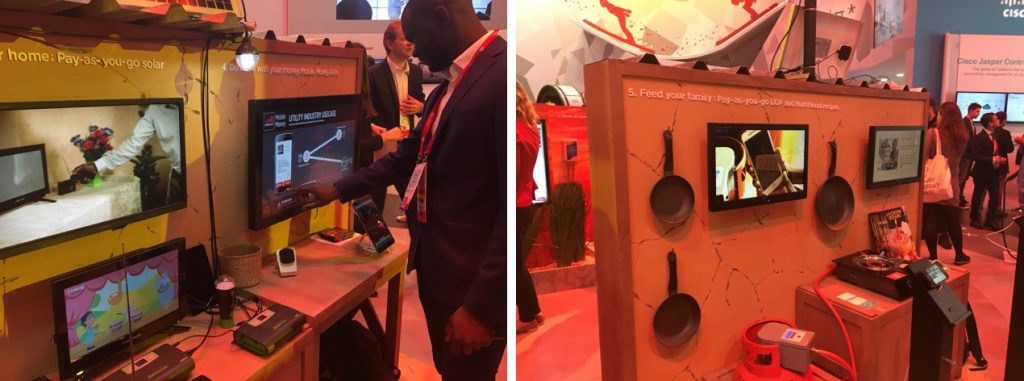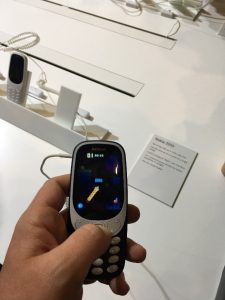From 27 February to 2 March 2017, the GSMA Ecosystem Accelerator team took part in Mobile World Congress and 4YFN in Barcelona. Both events gathered over 108,000 professionals from the mobile industry. While a blog post cannot suffice to cover events of this magnitude, we wanted to share three quick takeaways relevant to our programme’s specific scope and geographies.
1. The growing participation of emerging markets start-ups
While Mobile World Congress has been a recognised global industry event for several years, 4YFN was only in its fourth edition this year. With 19,000 attendees, the start-up focused event has already amassed scale and its participation is becoming increasingly global. Emerging markets ecosystems were well represented with start-ups from Colombia, Argentina, Pakistan, India, Sri Lanka, Tunisia, Morocco, Kenya, Georgia and Armenia among others.
Martin Karanja (the programme’s Senior Engagement Manager) was one of the judges at the finals of the Global Mobile Challenge and – beyond the 3 winners (Protect me, Wings for all and Shopback) – was particularly impressed by the pitches of:
- Securella (Morocco): A wearable with a panic button to send an alert to friends and family, community members, people nearby, police and emergency services
- Talking Bookz (Nigeria): A mobile application to download and listen to audio books
These two start-ups demonstrated the efforts deployed by emerging markets entrepreneurs to tackle local challenges (safety and literacy in those cases) while building a commercial business. This point was reinforced by most of the start-ups we met. Some examples include:
- GetPayAd (Pakistan): A sponsored advertising service allowing low-income mobile users to earn airtime and advertisers to engage with their audience
- SenzMate (Sri Lanka): An IoT device and service for farmers that automates irrigation valves according to weather conditions in the farm therefore improving productivity
Interestingly, these two start-ups have been closely supported by local mobile operators (Mobilink Pakistan and Dialog Sri Lanka) which have respectively enrolled them in their accelerator programme (Jazz xlr8) and opened their APIs to them (Ideamart).
2. Collaboration between ‘corporates’ & start-up taking central stage
Collaboration between corporates (mobile operators in particular) and start-ups is becoming increasingly relevant for both sets of stakeholders, especially in emerging markets, and it was not surprising to see this becoming a central topic across both events. At least four workshops and panels were dedicated to this topic during the three days of 4YFN, and mobile operators were systematically represented by the likes of Orange, Telefonica, Deutsche Telekom, Millicom and Singtel among others.
Match-Maker Ventures reiterated the importance of start-ups and corporates understanding the rationale (the “why”) before entering a potential collaboration. A panel of corporate venture leaders insisted on the need for a strong strategic fit between the ‘corporate’ and the start-up in any venture deal. We were also invited to share our programme’s views in a panel titled “Dancing with giants: how corporations can collaborate with start-ups”. Orange took advantage of this panel to reveal that the French operator has allocated new funding to start-ups in Africa and the Middle East. On our side, the panel was an opportunity to insist on the need for start-ups and mobile operators to clearly identify synergies before collaborating. WhatAVenture, also represented at the panel, focused on the corporate side and shared some pointers as noted in their latest white paper:
- 1. Understand start-ups and how they differ
- 2. Define your goals
- 3. Set the right framework
- 4. Choose the right framework for you
- 5. Get started by creating a win-win situation
Although a number of mobile operators have gone through the process and have started a number of initiatives to collaborate with local start-ups, the above steps are applicable to them. One of these initiatives, Go-Ignite, is now in its second year and aims to open the doors of Singtel, Orange, Deutsche Telekom and Telefonica to selected start-ups. The four operators launched the second global call of this initiative which is now seeking growth stage start-ups that have market-ready solutions in Consumer Experience Artificial Intelligence (AI), Connected Homes, or Internet of Things (IoT) Security.
Changing site but not topic, the first session of the GSMA Mobile for Development “Innovate To Lead” seminar at Mobile World Congress brought together mobile operators (Millicom and Telefonica), investors (Global Innovation Fund, Nest.vc) and start-ups (Kopa Gas) to focus on how mobile operators are working with start-ups in emerging markets to foster digital inclusion.

3. Bridging the gap between the telecom and innovator worlds
While jumping from one event to another, it was very encouraging to experience how, over the years, the boundaries between the two events and two worlds (start-ups at 4YFN and mobile operators/vendors at Mobile World Congress) are blurring.
On the one hand, mobile operators are now present and active in front of start-ups at 4YFN through specific sessions as highlighted previously, but also among exhibitors. Some operators like Veon (previously known Vimpelcom) and Zain had their own booths with selected start-ups from their in-house acceleration programmes.
On the other hand, emerging markets start-ups and innovators were increasingly present at Mobile World Congress:
- Several innovations and start-ups were showcased at the GSMA Mobile for Development “Rural Village”, like off-grid households solution M-Kopa (Kenya), weather forecast for agriculture service Site Pyo (Myanmar), pay-as-you-go LPG distribution service KopaGas (Tanzania) and automated irrigation systems for rural areas Nano Ganesh (India).
- Some start-ups, like crowd-sourced agriculture knowledge sharing platform WeFarm (Kenya, Uganda) who won 4YFN Award under the ‘Disrupted by Mobile’ category, also pitched on one of the main stages at Mobile World Congress.

Naturally, we could not conclude this post without mentioning that a lot of the events’ buzz was stolen by a tiny device, very well known in emerging markets: the Nokia 3310. And yes, the revamped model still features a long tenure battery and its famous torch.



